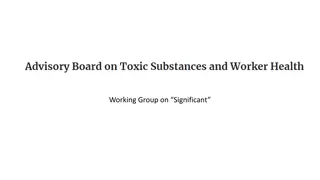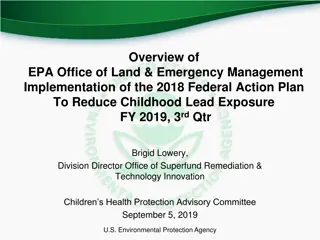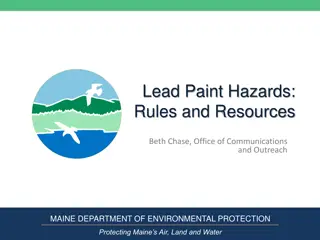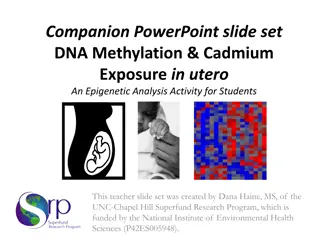Understanding NHANES Data for Environmental Exposure Studies
National Health and Nutrition Examination Survey (NHANES) is a crucial population-based survey in the U.S. that collects data on health and nutritional status. This data supports various applications, including assessing human exposure to environmental chemicals. NHANES conducts biomonitoring to qua
5 views • 27 slides
Understanding the Impact of Lead Contamination on Human Health and Ecosystems
Exploring the detrimental effects of lead exposure on human health and the environment, this content touches on lead contamination in drinking water, its effects on various bodily systems, and its impact on ecosystems. It also delves into the history of lead usage, major contributors to lead polluti
0 views • 18 slides
Pediatric Lead Prevention Initiative: Best Practices and Screening Performance
This initiative focuses on lead screening in pediatric patients, emphasizing the importance of testing due to the absence of a safe lead level. The program aims to improve compliance with lead testing regulations, including Medi-Cal mandates, and introduce new clinical measures for lead screening. I
1 views • 18 slides
Occupational Heat Exposure Control and Prevention Practices
Occupational Heat Exposure Control and Prevention Practices at the New Mexico Institute of Mining and Technology covers training for workers exposed to excessive heat, pre-test evaluation, objectives focusing on heat stress and exposure, understanding heat and heat stress, human body's response to h
1 views • 37 slides
Understanding the Significance of Exposure in EEOICPA Procedures
Delve into the complexities of exposure assessment in the context of EEOICPA procedures, examining the nuances of significant exposure levels and their impact on causation determination. Explore proposed recommendations for refining exposure assessment metrics to enhance causation evaluation.
0 views • 9 slides
Nitrous Oxide Occupational Exposure Guidelines and Monitoring
This information covers the occupational exposure to nitrous oxide, including its uses, chemical description, routes of exposure, health effects, monitoring methods, and regulatory exposure limits. Nitrous oxide is a colorless gas with various applications in medical, dental, and food processing ind
2 views • 18 slides
Understanding Radiation Safety for XL2 Analyzers
The Niton Model XL2 analyzer uses an X-ray tube that emits radiation when turned on, requiring adherence to the ALARA principle to minimize exposure. Factors like time, distance, and shielding play crucial roles in managing radiation exposure. Learn how to stay safe while using the XL2 analyzer to e
0 views • 11 slides
Understanding Occupational Exposure to Formaldehyde
Occupational exposure to formaldehyde is common in various industries and settings, including medical laboratories and mortuaries. Formaldehyde is used as a preservative, embalming agent, and in the manufacture of various products. It poses health risks through inhalation and skin exposure, potentia
0 views • 14 slides
Early Childhood Language Learning and Bilingualism
Early childhood is a critical period for language acquisition and the development of bilingualism. Exposure to multiple languages from a young age has significant cognitive benefits. Bilingualism is a common phenomenon worldwide, with many individuals speaking more than one language. The cognitive i
0 views • 109 slides
Lead Poisoning Prevention in Child Care Settings
Lead poisoning is a significant concern for children, particularly those under six years old. Exposure to lead can have severe consequences on their health and development. This resource provides important insights on identifying and minimizing lead exposure risks in child care environments. It emph
0 views • 18 slides
Evolution of Early Childhood Intervention in Hungary
Early childhood intervention in Hungary has evolved from an emphasis on early childhood education towards an interdisciplinary, family-focused approach. The sectors involved include healthcare, education, welfare, and family affairs. A wide range of professionals, including health visitors, physicia
0 views • 10 slides
Enhancing Pesticide Exposure Assessment for Epidemiological Studies
Focuses on IMPRESS project aiming to improve methodologies for assessing occupational pesticide exposure in epidemiological studies. Reviews challenges in retrospective exposure assessment, proposes methodologies, and presents key project results to date, emphasizing the use of various exposure asse
1 views • 15 slides
Pesticide Exposure Assessment in Farmers from Malaysia, Uganda, and the United Kingdom
This study evaluates the impact of pesticide exposure on farmers' health in Malaysia, Uganda, and the UK using urinary biomarker concentrations. Multiple cohorts are analyzed to assess associations between exposure-modifying factors and urine metabolite measurements. The IMPRESS project focuses on i
0 views • 12 slides
Understanding Personal Exposure to Polybrominated Diphenyl Ethers (PBDEs)
This presentation explores the exposure of individuals to PBDEs in residential indoor air, highlighting the background, commercial uses, exposure pathways, and previous studies on PBDEs. It discusses the objectives, methods, results, and conclusions of a study aiming to quantify indoor air exposure
0 views • 22 slides
Understanding Lead Exposure and Environmental Hazards
Lead, a soft metal abundant in the environment, has been used for various purposes throughout history. Exposure to lead can lead to serious health issues, especially in children. The impact of lead on public health and the environment, including its presence in gasoline and its effects on human heal
1 views • 17 slides
Childhood Lead Poisoning Prevention Program Overview
This content highlights the importance of preventing childhood lead poisoning, discussing its risks, health effects, sources, and testing methods. It emphasizes the need for early detection and provides essential information for parents and caregivers on reducing lead exposure in young children.
0 views • 26 slides
Preventing Exposure to Lead in Drinking Water - Initiative Briefing
Lead, a common but toxic element, poses health risks, especially to infants and pregnant women. This project briefing highlights the historical use of lead in plumbing, current regulations under the EPA, and recommendations to prevent lead exposure in schools and child care facilities.
0 views • 8 slides
Lead-Based Paint Technical Assistance Overview
This content provides an in-depth exploration of lead-based paint, covering its history, regulations, health effects, and the HUD's Lead Safe Housing Rule. It discusses the dangers of lead exposure, especially to children and pregnant women, and outlines the exemptions to the LSHR. The presentation
0 views • 26 slides
EPA Office of Land & Emergency Management Overview on Lead Exposure Reduction
EPA's Office of Land & Emergency Management (OLEM) implements various programs to address lead contamination, focusing on reducing childhood lead exposure through cooperative efforts at federal, state, tribal, and local levels. OLEM supports an integrated approach to addressing multiple lead exposur
0 views • 9 slides
Photography Basics: Understanding Camera Exposure and Metering
Explore the fundamentals of camera exposure, including aperture, shutter speed, ISO, and metering modes. Learn how to control exposure settings, utilize different metering modes, and troubleshoot common exposure issues to enhance your photography skills.
0 views • 15 slides
Bloodborne Pathogens Exposure: HIV Post Exposure Prophylaxis Regimen
Take immediate action for exposure to bloodborne pathogens like HIV and Hepatitis C through a post-exposure prophylaxis (PEP) regimen. Administer PEP within 48 hours for increased-risk exposures like needle sticks or contact with infected fluids. Coordinate evacuation if needed and conduct Rapid Dia
0 views • 5 slides
Understanding Cyanide: Sources, Exposure, and Risks
Cyanide is a toxic compound found in various forms such as gases, solids, and liquids that can be harmful to humans and animals. Sources of cyanide exposure include natural processes, industrial activities, plant sources, and combustion products like cigarette smoke. The extent of poisoning depends
0 views • 14 slides
Occupational Pesticide Safety and Health Concerns
Occupational safety and health issues related to pesticide exposure are a significant concern globally. Limited surveillance data on pesticide exposure and related illnesses are available, with a high percentage of farmers being affected annually. Various occupations beyond farming also face potenti
1 views • 25 slides
Lead Paint Hazards Rules and Resources in Maine Department of Environmental Protection
In Maine, the Department of Environmental Protection provides crucial information on lead paint hazards, regulations, and resources. The content covers topics such as disturbing lead-based paint, emergency provisions, federal laws on lead renovation, repair, and painting, disclosure rules, and housi
0 views • 7 slides
North Carolina Childhood Lead Poisoning Prevention Program Updates
The North Carolina Childhood Lead Poisoning Prevention Program, managed by Ed Norman, MPH, is implementing proposed temporary rules and receiving funds for lead testing and remediation. Public schools and licensed child care facilities are affected by the regulations, with specific requirements for
2 views • 8 slides
Understanding Attraction and the Mere Exposure Effect
Explore the dynamics of attraction and romantic love, delving into why we are drawn to certain individuals and how familiarity influences our feelings. Uncover key factors such as proximity, attractiveness, and similarity, along with the intriguing concept of the mere exposure effect, which elucidat
0 views • 37 slides
Understanding DNA Methylation and Cadmium Exposure in Utero: An Epigenetic Analysis
Explore the complex relationship between DNA methylation and in utero exposure to cadmium through a set of informative slides created by Dana Haine, MS. Learn about the impacts of DNA methylation on gene expression and how changes in methylation levels can lead to gene silencing or activation. Disco
0 views • 8 slides
Understanding Adverse Childhood Experiences (ACE) Study and Findings
The Adverse Childhood Experiences (ACE) Study conducted by CDC and Kaiser Permanente examines the impact of childhood trauma on health outcomes. It defines and discusses various ACE factors like abuse, neglect, and household dysfunction. The study reveals that such experiences in childhood can signi
0 views • 30 slides
Occupational Safety and Health Concerns with Crystalline Silica Exposure
Crystalline silica exposure poses serious health risks, including chronic silicosis, lung cancer, COPD, and kidney diseases. OSHA addresses this issue through programs like NEP, enforcing exposure limits, and requiring safety measures in the construction industry such as respiratory protection and e
0 views • 23 slides
Developing the Illinois Early Childhood Participation Data Set
The Illinois Early Childhood Asset Map project aims to develop the Illinois Early Childhood Participation Data Set (ECPDS) in collaboration with various organizations and agencies, including the University of Illinois, Chapin Hall, Northern Illinois University, ISBE, IDHS, and ILDS. This initiative
0 views • 7 slides
Enhancing Developmental Screening and Referral Systems for North Dakota's Early Childhood Partners
North Dakota's journey in sharing data across early childhood partners involves various agencies such as the Department of Health, Public Instruction, Human Services, and more. Spearheaded by Prevent Child Abuse North Dakota (PCAND), initiatives like the Early Childhood Comprehensive System (ECCS) a
1 views • 9 slides
Occupational Exposure Guidance Relating to Asbestos
Asbestos-related diseases such as asbestosis, lung cancer, and mesothelioma pose risks to workers, especially those in specific occupations. The EEOICPA Circular No. 15-05 provides guidance on assessing potential asbestos exposure for Department of Energy (DOE) workers post-1986, emphasizing the nee
0 views • 18 slides
Historical Occupational Exposures to Lead in Pre-Industrialized Times
Occupational exposure to lead in pre-industrialized times dates back to ancient eras, with Romans and artisans using lead in various applications. Lead toxicity was observed early on, with artisans like goldsmiths and artists being at risk. Physicians in the Renaissance era recognized the dangers of
0 views • 10 slides
PACT ACT of 2022: Addressing Comprehensive Toxics Exposure for Veterans
The PACT ACT of 2022, spearheaded by Sergeant First Class Heath Robinson, aims to address comprehensive toxics exposure issues for veterans. The bill includes provisions such as expanded healthcare, improved VA services, recognition of burn pit exposure, enhancement of compensation for Persian Gulf
0 views • 22 slides
Understanding Economic Exposure in International Finance
Explore the concepts of economic exposure and translation exposure in international finance through a case study of Savor Co., a U.S. firm with business units in Europe. Learn how regression analysis is used to assess exposure to currency movements and identify potential hedging strategies to mitiga
0 views • 24 slides
Understanding Environmental Impacts on Housing: Regulating Pollution Exposure Pathways
Explore the regulatory framework for managing pollutant exposure in homes, highlighting the complexity of exposure pathways and the importance of assessing risks based on toxicity and exposure levels. The discussion covers various exposure pathways such as drinking water, air quality, dermal contact
0 views • 14 slides
RF Exposure for Amateur Radio: Understanding Sources and Safety Measures
Exploring the various sources of RF exposure in relation to amateur radio, this comprehensive guide by Harold C. Fleischer, III AE5AS sheds light on different antennas like those used by AM, FM radio stations, TV stations, MW telecommunications, police, taxis, and even Wi-Fi routers. Each image show
0 views • 39 slides
OSHA's Respirable Crystalline Silica Rule Overview
Exposure to respirable crystalline silica can lead to serious health risks including silicosis, lung cancer, COPD, and kidney disease. The rule covers the scope of coverage, permissible exposure limits, exposure assessment methods, and requirements for construction sites. It emphasizes the importanc
0 views • 31 slides
Clinical Response to PFAS Exposure in the General Population
Exposure to PFAS (per- and polyfluoroalkyl substances) is prevalent among Americans, with pregnant women showing detectable levels. Screening for health effects of exposure includes assessing cholesterol, thyroid function, and other symptoms. There is no known safe level of PFAS exposure, and orderi
0 views • 14 slides
Understanding the Long-Term Effects of Lead Exposure
Lead exposure can have detrimental effects on individuals, especially children. From damaging neurons to causing behavioral issues and slow development, the impact of lead exposure can be severe. Prevention through identifying sources of exposure and living safely with lead is crucial. Lead test kit
0 views • 13 slides







































